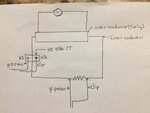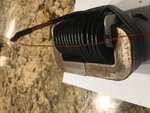Easy peasy
Advanced Member level 6
50 Hz is way too low for 13 turns on an unknown core size
for ferrite Bpk < 0.3T Bpk = Erms /( 4.44 F. N Ae ) for sine wave. Ae = ferrite core area, N = turns, F = Hz
- - - Updated - - -
area in m^2
for ferrite Bpk < 0.3T Bpk = Erms /( 4.44 F. N Ae ) for sine wave. Ae = ferrite core area, N = turns, F = Hz
- - - Updated - - -
area in m^2



